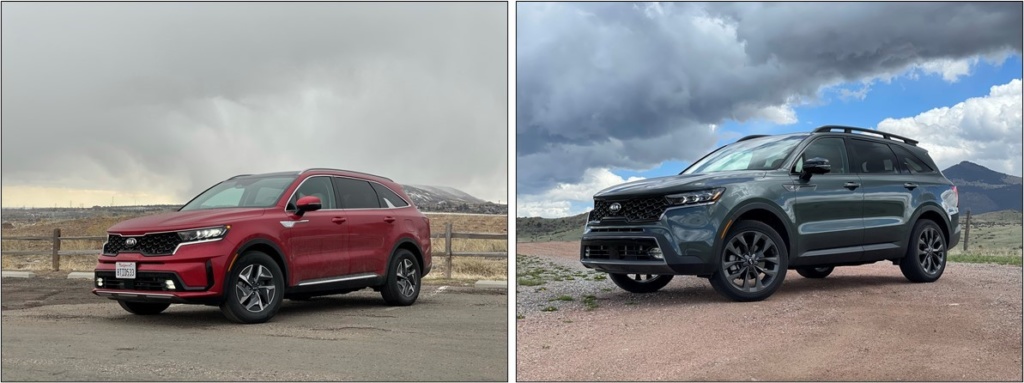
This was so close to being a home run for Kia. The redesigned Sorento offers powertrain diversity that reaches both ends of the performance spectrum, an exterior that is bold without being offensive, an interior that is appreciatively practical, and it carries an undeniable sense of value. So what is it that keeps both of these models from being winning standouts?
The Sorento fits into an interesting place among its similarly priced competition because it’s a bit larger than the CR-V and RAV4 crowd, offers more high-end features, and includes a third row albeit for kids. Even its powertrain offerings are more powerful. Compared to bigger competitors such as the Highlander and the Pilot, the Sorento can be seen as just the right size and a solid value.

The exterior is a departure from the previous generation’s rounded and reserved shape. Now, crisp lines, strong wheel arches, and distinctive lighting make this crossover stand out among the sea of competitors. And the design is flexible enough to adapt unique styling touches to present either a sleek look that’s fitting for the Hybrid or a rugged shape that exudes an adventurous spirit for the X-Line trim.

The interior follows suit with unique touches. The Hybrid receives silver interior trim with cross-hatch surfacing, a rotary shift controller, and a large physical power meter dial in the gauge cluster. In this top Hybrid EX trim, LED headlights, heated synthetic leather seats, a leather-wrapped steering wheel, enough charge ports for everyone on board, and a large panoramic sunroof that presents a desirable blend of features and functionality. The X-Line trim reaches further into the luxury space with matte wood interior trim, heated and ventilated leather seats with a quilted stitch pattern, a worthy Bose premium sound system, a surround-view monitor, and a 12.3-inch gauge cluster display whose crisp graphics and creative animations are nearly worth the price increase alone. The X-Line also gains a blind-spot view monitor which is similar to Honda’s system except that it shows both sides of the vehicle and projects the real-time image in the gauge cluster instead of the central infotainment screen. This proved to be better overall and is helpful both, on the highway and around town where cyclists might approach alongside.

The X-Line also replaces the Hybrid’s laughably outdated infographics for a detailed 10.25-inch unit that is much more in line with what is expected in today’s modern crossovers.
Both models feature good interior space with a “four + two” seating arrangement, indicating that the third row is intended for children or as a last resort for adults. Unfortunately, the front seats are not very comfortable either with a short seat cushion and a flat shape. The second row’s captain’s chairs are placed low to the floor but at least there is plenty of room to shift around on longer trips.

Around town, both Sorento models are a challenge to drive smoothly but for different reasons. The Hybrid’s electrified powertrain spec-sheet is enticing with a 1.6-liter turbocharged four-cylinder which delivers sufficient acceleration up to highway speeds without a noisy protest – an area where hybrids typically struggle.

Unfortunately, the initial pedal response is so delayed that low-speed maneuvers turn into an uncoordinated wait-wait-whoa series of events. The braking system also lacks the polished feel as the system sharply transitions from energy recuperation to providing energy for forward creep that results in a slight lurch forward when coming to a stop with light pedal pressure.

The X-Line’s powerful 2.5-liter four-cylinder turbocharged engine is also impressive with its stats (281 horsepower and 311 lb-ft of torque) but its 8-speed dual-clutch transmission is lacking low-speed refinement. The nature of the DCT is to remain disengaged until forward motivation is requested, at which point, it balances the clutch engagement but when the clutch can’t find the precise pressure balance, notable juddering results, and, in the Sorento, that happens frequently. Hard launches, on the other hand, are smooth but sound painful as the clutch audibly allows for slip to allow the engine to quickly rev and build turbo boost. At least there’s a transmission temperature gauge to monitor the internal conditions. Once underway, the DCT lacks the fast and crisp shifts that they are known to deliver and causes one to question if it was the best choice for this 4,000+ everyday crossover.

Both models provide a composed ride whether on the highway or around town. There’s noticeable body roll in tight turns but the steering effort is good and overall, the Sorento feels nimble. Good outward visibility is also a boon to stress-free driving but, interestingly, it’s the driving assist features that portray nervousness with constant minor steering adjustments even on straight highway sections.
With all of the different aspects – styling, spaciousness, features, driving experience – it’s challenging for vehicles to hit a home run. In the case of the Sorento, both models present a strong performance but their powertrains require too much concentration to drive smoothly.
There is an undeniable sense of value, but for me, the Sorento models ask for too much in return.
